Designing for Non-humans as an Act of Service
September 20, 2023
HUMANS’ RESPONSIBILITY AS STEWARDS
The relationship between humans and animals is complex and multifaceted. When it comes to designing shelters for animals, our minds often conjure images of professional architects and engineers devising innovative and functional structures for zoos, wildlife parks or conservation centres. Animals are generally only cared for if they are of any direct benefit to humans. However, an equally vital but often overlooked aspect of animal shelter design exists—one done as an act of service. Across the globe, people share a profound cultural and emotional connection with animals, embodying their respect, care and gratitude by constructing shelters for them.

Designing for animals thus becomes about recognising our responsibility as stewards of the Earth and preserving biodiversity.


Sketches of Mohammed Arif Khan and the Sarus crane. Drawings by Nipun Prabhakar
There was a story from Uttar Pradesh, India, of a man forging an unlikely but heartwarming connection with a Sarus crane. Mohammed Arif Khan found an injured crane and took it upon himself to care and tend to it, but the crane refused to leave him after it healed, after which the pair became an internet sensation, doing activities together, him on the bike and the crane flying alongside. But the government punished Khan under the Wildlife Act and took the crane away from him, locking it behind bars in a zoo.
The flashpoint here was the divergent notion of what constitutes an appropriate animal shelter—the conventional bureaucratic view clashing with the simple, universal and fraternal idea of cohabitation.
ARCHITECTURES OF CONTROL
Historically employed for animal captivity, structures like cages were also used to perpetuate racial otherness. Disturbingly, imperial powers would display African people in such cages, with instances as late as 1906 in the Brooklyn Zoo1.
Similarly, during colonial times, discriminatory signage reading “dogs and Indians are not allowed” adorned restricted cafes and buildings in places like India. Architecture, renowned for its capacity to influence human behaviour and social dynamics, has been equally employed as a tool of control for the ‘other’, including animals.



Many zoos and wildlife parks, most of which are meant for human entertainment, have a deliberate design of enclosures that dictates the movements and interactions of the inhabitants. These structures often feature barriers, such as walls and fences, strategically placed to confine animals to specific areas and prevent them from escaping.
The spatial layout of these enclosures can manipulate the animals’ behaviour by providing or restricting access to various resources. Placing food and water sources along the configuration of paths and tunnels influences the animals’ movement patterns and social dynamics within their captive environments.
READ MORE | Writer’s Note: Creating Spaces for Animals
In the case of domesticated animals, we build confinement systems such as barns and cages. Architectural design impacts the psychology of animals in many ways. For example, the design of animal shed/handling facilities can impact the ease and safety when moving animals, possibly affecting their mental health. Or, the design of a facility could affect the time it takes to milk each cow, which could correlate to the level of stress on the animals.
Even so, incorporating natural elements and design principles, as well as environmentally friendly materials in these structures should be seen as a basic step towards improving the way such structures are designed, so that the animals may benefit from being in more naturalistic environments.


ARCHITECTURE AS AN ACT OF SERVICE
Animals do not necessarily require built spaces in the same way as humans do. Different species have evolved to create their structures and habitats based on their specific needs and natural instincts.
We all know about the intricate nests built by weaver birds, the complex underground tunnels created by ants, or the elaborate dams constructed by beavers (also called nature’s architects). These natural constructions serve as a testament to the remarkable abilities of non-human creatures to adapt and shape their habitats and environments.
Designing for animals thus becomes about recognising our responsibility as stewards of the Earth and preserving biodiversity. Creating suitable habitats helps mitigate the negative impacts of human development and supports wildlife populations.
There are architects who are focusing on designing animal habitats by collaborating with zoological and entomological specialists. These projects challenge traditional disciplinary and epistemological territories, suggesting a shift away from the historical architectural positioning of urban animals as either pests or curiosities.
[This is an excerpt. Subscribe to the digital edition or hardcopy to read the complete article.]

Nipun Prabhakar is an independent documentary photographer and architect based in India. He works on long-term projects dealing with intersections of ideas, artifacts, the built environment and folklore. His background as an architect has deeply impacted his sense of space in situations that call for a contextual response to culture and geography. His work has been supported by the Aga Khan Trust for Culture, AKDC at MIT, among others. He is a recipient of the Berkeley Essay Prize 2014 and was Cornell University’s South Asian Fellow 2019-20.
Read more stories from FuturArc 3Q 2023 Green Awards: Cross-Generational Architecture!

Bibliography
1 Dobraszczyk, Paul. Animal Architecture: Beasts, Buildings and Us. Reaktion Books, 2023.
2 Christiane Gruber. ‘Like Hearts of Birds: Ottoman Avian Microarchitecture in the Eighteenth Century’. Journal18: A Journal of Eighteenth-Century Art and Culture, Apr. 2021, https://www.journal18.org/issue11/like-hearts-ofbirds-ottoman-avian-microarchitecture-in-the-eighteenthcentury/.
3 Building Collisions Kill Hundreds of Millions of Birds per Year | Audubon. 30 Jan. 2018, https://www.audubon.org/news/building-collisions-kill-hundreds-millions-birds-year.
4 ‘First in Country: A Flyover for Animals on Mumbai-Nagpur Highway’. The Times of India, 23 Feb. 2022. The Economic Times – The Times of India, https://timesofindia.indiatimes.com/city/nagpur/eco-bridges-on-e-way-samruddhi-for-all/articleshow/89757839.cms.
5 Prabhakar, Nipun. ‘Documenting India’s Distinctive Birdhouses’. The New York Times, 27 June 2022. NYTimes.com, https://www.nytimes.com/2022/06/27/travel/birdhouses-kutch-district-india.html.
To read the complete article, get your hardcopy at our online shop/newsstands/major bookstores; subscribe to FuturArc or download the FuturArc App to read the issues.
Previously Published Commentary
Contact us at https://www.futurarc.com/contact-us for older commentaries.
